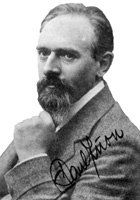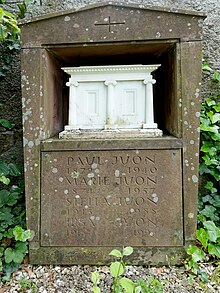Paul Juon
Paul Juon (actually Павел Фёдорович Юон / Pavel Fedorovich Juon , * 6. March 1872 in Moscow , Russian Empire ; † 21st August 1940 in Vevey ) was mainly in Germany acting Swiss composer of Russian descent.
Life
Paul Juon was the son of the insurance employee Theodor Friedrich Juon (* 1842), his grandfather came to Russia as a confectioner from Masein , Graubünden . His brothers were the painter Konstantin Juon and the mining engineer and Russian military officer Eduard Juon. Paul Juon studied at the Moscow Conservatory with Jan Hřímalý , Sergei Iwanowitsch Tanejew and Anton Stepanowitsch Arenski and in Berlin with Woldemar Bargiel . There he received the Mendelssohn Prize for Composition in 1896 .
From 1896 to 1897 he taught music theory and violin at the Baku Conservatory , after which he returned to Berlin, where in 1906 he was appointed professor of composition at the Hochschule für Musik by Joseph Joachim . His students include Hans Chemin-Petit , Werner Richard Heymann , Nikos Skalkottas , Henry Jolles , Pantscho Wladigerow , Philipp Jarnach , Heinrich Kaminski , Lauri Ikonen , Georg Ahl , Max Trapp , Yrjö Kilpinen , Gerhart von Westerman , Hans Moltkau , Giannis Konstantinidis , Wilhelm Guttmann , Stefan Wolpe and Marc-André Souchay .
Since 1934 he lived in Switzerland .
Juon married Marie, called Armande (1874–1957) in 1912. She was previously the wife of the Basel composer Otto Hegner, who died in 1907 . Together they had three children: Stella (1913–1988) and Irsa (1915–1996) and Rémi. They found their final resting place in the Langenbruck cemetery.
style
Juon composed four symphonies , a ballet , a piano and three violin concertos, other pieces for violin and orchestra, episodes concertants for violin, cello, piano and orchestra, chamber music works, sonatas for various instruments and songs in an independent late romantic style . Juon's music is not easily detailed, but worked through in a formally demanding manner. He often used Russian or Nordic themes and transformed them into art music through formal means. In doing so, he kept the sound of national music. Furthermore, he used rare time signatures, and the frequent change of time signature is a special feature of all his compositions. Paul Juon (around 1908, Simrock edition, Leipzig) also created at least one orchestration of a third-party composition. He arranged the piano version of the 4th dance from the Hungarian Dances by Johannes Brahms for orchestral work.
His estate has been in the Lausanne cantonal and university library since 1995 . In 1998 the International Juon Society was founded.
Works
A complete catalog of works by genre and opus numbers at IMSLP
- Stage works
- Aleko , Opera, 1896
- The golden temple book , incidental music, 1912
- The poor broom-makers , incidental music, 1913
- Orchestral works
- op.3a 1894 Ingeborg's complaint
- op. 10 1895 Symphony in F sharp minor
- op. 23 1903 Symphony in A major
- op. 31 1906 Wächterweise, fantasy based on Danish folk l.
- op. 32A 1910 Ballet Suite from the dance poem "Psyche"
- op. 35 1906 From a diary, symphonic sketches
- op. 40 1909 A serenade music
- op. 93 1935 Suite in five movements for large orchestra
- op. 94 1938 Grace and Dignity, suite for orchestra
- op. 95 1939 Rhapsodic Symphony
- op. 96 1940 dance caprices
- op. 98 1939 Sinfonietta capricciosa
- Instrumental concerts
- op. 42 1909 Violin Concerto in B minor
- op. 45 1912 concert piece "Episodes concertantes"
- op. 49 1912 Violin Concerto in A major
- op. 59 1928 Mysteries for violoncello and orchestra
- op. 88 1931 Violin Concerto in A minor
- op. 97 1940 Burletta for violin and orchestra
- String orchestra
- op. 16 1901 Five pieces for string orchestra
- op. 85 1928 Little Serenade (for school orchestra)
- op. 87 1929 Little Symphony (for school orchestra)
- op. 92 1933 Divertimento (for school orchestra)
- Chamber music
- opus 17 Trio for violin, violoncello and piano No 1
- op. 18 No. 3 Trio miniatures for clarinet, violoncello a. piano
- op.27 1905 Chamber Symphony (octet for vl., vla., vcl., oboe, clarinet, horn, bassoon and piano)
- op. 33 quintet for violin, 2 violas, violoncello a. piano
- op. 37 piano quartet "Rhapsody", for violin, viola, violoncello a. piano
- op. 39 Trio Caprice in D major, (based on “Gösta Berling” by Selma Lagerlöf), for violin, violoncello a. piano
- op. 44 quintet for 2 violins, viola, violoncello a. piano
- op. 50 piano quartet [No. 2], for violin, viola, violoncello a. piano
- op. 54 Sonata in A minor, for violoncello and piano
- Chamber m. for winds
- op. 51 Divertimento, for flute, oboe, clarinet, horn, bassoon a. piano
- op. 84 Wind Quintet in B flat major
- piano
- op. 65 1915 Four pieces for piano: No.1 Cheerful ways; No.2 slumber song; No.3 exotic interlude; No.4 dance
- op. 76 1923 cacti, 7 piano pieces
Fonts
- Practical harmony . 1901
- Translation of the Tchaikovsky biography by Modest I. Tschaikowsky , 1903
- Instructions for modulating . 1929
literature
- Thomas-M. Langner: Juon, Paul. In: New German Biography (NDB). Volume 10, Duncker & Humblot, Berlin 1974, ISBN 3-428-00191-5 , p. 698 f. ( Digitized version ).
Web links
- Works by and about Paul Juon in the catalog of the German National Library
- Sheet music and audio files by Paul Juon in the International Music Score Library Project
- Roman Bühler: Juon, Paul. In: Historical Lexicon of Switzerland .
- The International Juon Society
- Catalog of works on Klassika
- Short biography at fattore.com (French)
- Werner Theurich: Der Stilzauberer: rediscovery of Paul Juon. Spiegel Online , August 9, 2015.
Individual evidence
- ^ Roman Bühler: Eduard Juon. In: Historical Lexicon of Switzerland . March 25, 2010, accessed July 23, 2020 .
- ↑ Eberhard Preussner: Paul Juon. In: Allgemeine Musik-Zeitung. Berlin June 11, 1926.
| personal data | |
|---|---|
| SURNAME | Juon, Paul |
| ALTERNATIVE NAMES | Juon, Pavel Fyodorowitsch; Юон, Павел Фёдорович |
| BRIEF DESCRIPTION | Swiss-Russian composer |
| DATE OF BIRTH | March 6, 1872 |
| PLACE OF BIRTH | Moscow |
| DATE OF DEATH | August 21, 1940 |
| Place of death | Vevey |

